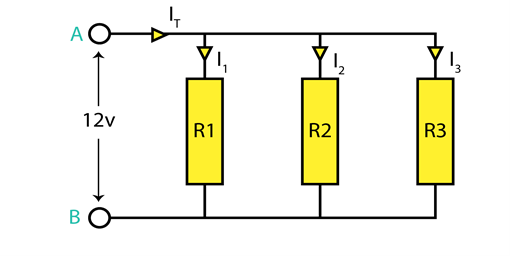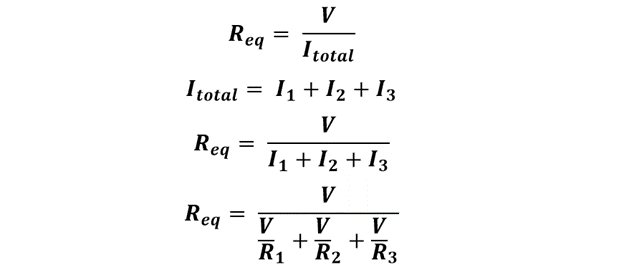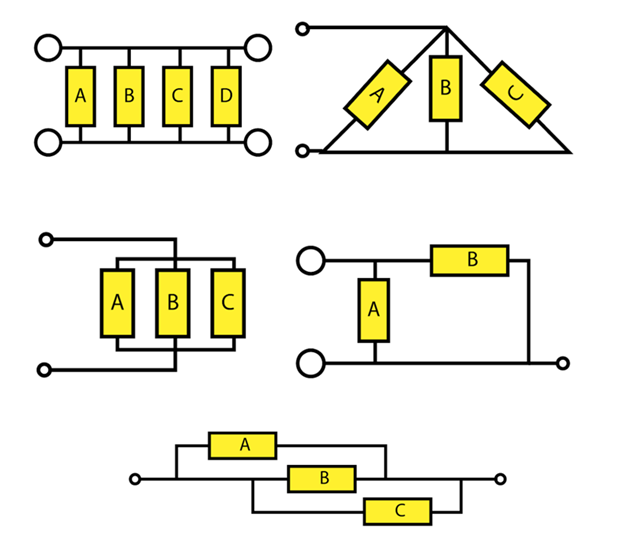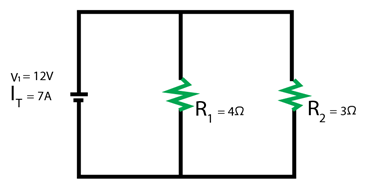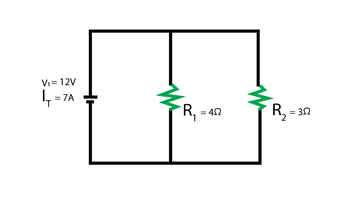Resistors in Parallel
Two or more resistors that are connected with the very same node from both terminals, such resistors connected in parallel. In this arrangement, current is divided among all resistors whereas voltage is constant across all resistors.
Properties of Resistors in Parallel
The two main properties of resistors connected in parallel are related to voltage and current. In parallel resistors circuit, all the resistances get the identical voltage as that of the source. However, current is distributed among the branches in a circuit. The rule for the distribution of current is that the smallest resistance will get the largest current. This concept is explained below in the next heading.
Resistances in Parallel and Ohm’s Law
Ohm’s law establishes that current flowing through a resistance or conductor varies directly according to the voltage across it, keeping environmental conditions constant.
The expression of Ohm’s Law can be given as:
Here, R is the resistance present in the path of the current.
In the case of resistances connected in parallel, Ohm’s law holds true. For every branch in a circuit, V=IR is valid.
How to Find Equivalent Resistance of Resistances Connected in Parallel?
To find the equivalent resistance of resistances connected in parallel, a formula for equivalent resistance is derived. Consider the circuit given below:
The above circuit shows three resistances connected in parallel that can be replaced by one equivalent resistance by solving them. For equivalent resistance, Ohm’s law will be:
V is canceled from the numerator and denominator and the equation gets simplified as:
So, this formula can be used to calculate equivalent resistance.
Distribution of Current among Resistors in Parallel
Current gets distributed among the branches of the circuit. The total current in a circuit within branches can be calculated by:
To find current in each branch of the circuit a current divider rule is followed which establishes that for finding current flowing through a resistance, the resistance of the opposite branch is taken in numerator and the sum of all resistances is taken in denominator multiplied by total current.
Some Forms of Resistances Connected in Parallel
Certain orientations of resistances in parallel are given below. As long as terminals of resistances are common, they are connected in parallel.
Example No. 1: Find the Equivalent Resistance of the Given Circuit
In the above-given circuit, two resistors R1 and R2 are connected in parallel and have values of 4 Ohms and 3 Ohms respectively. We are supposed to calculate the equivalent resistance of the circuit.
Example No. 2: Find the Current in Each Resistance Connected in Parallel for the Given Circuit
In the above-given circuit, two resistors R1 and R2 are connected in parallel having values of 4 Ohms and 3 Ohms respectively. The supply voltage given is 12V and the total current is 7A. We are supposed to determine the current in every resistor that is divided among them.
Current through resistor 3 Ω
Current through resistor 4 Ω
Conclusion
Resistances in parallel can be simplified easily and can be converted into one equivalent resistance to solve the circuit easily. Similarly, voltage is the same across all branches of the circuit but the current gets divided into branches, and from the above example we can conclude that the current is larger in smaller resistance and smaller in larger resistance.


